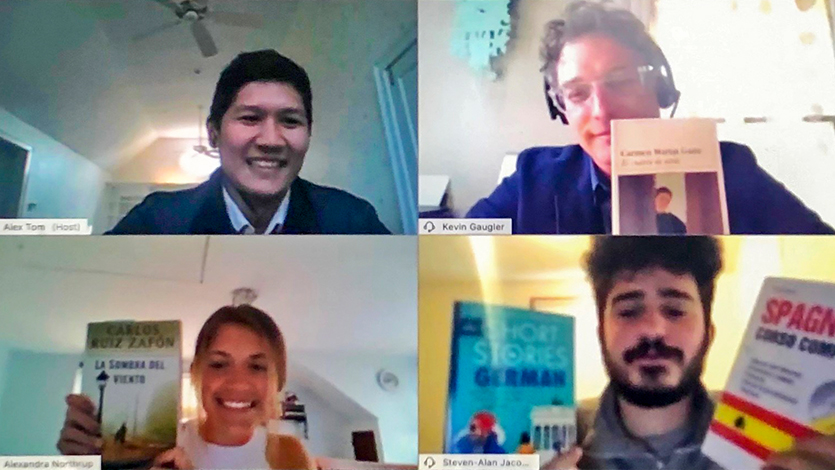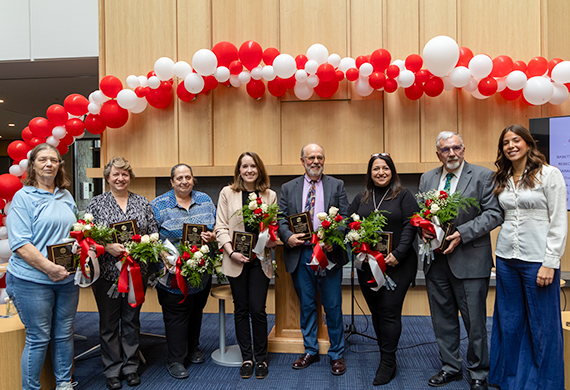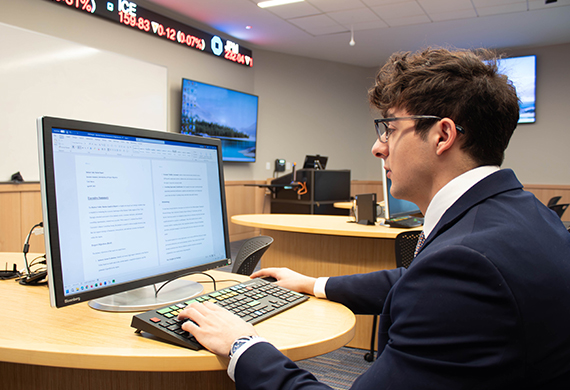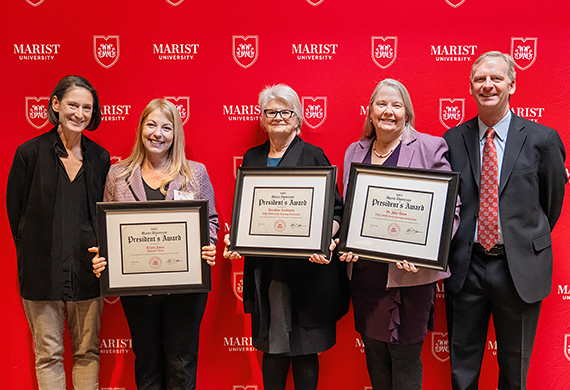The Big Move to Online Teaching and Learning

The College’s pivot to distance learning midway through the spring semester due to COVID-19 led to innovations.
June 17, 2020—In mid-March, as colleges and universities across the country were grappling with the impact of COVID-19, Marist College made the decision to move all courses online for the remainder of the Spring 2020 semester. This entailed moving 1700 in person classes to an online format in less than two weeks. Kevin Gaugler, Interim Assistant Dean of the School of Liberal Arts, applied his expertise in computer assisted language learning to the situation. He used his background in faculty second language teaching and learning to assist colleagues in other disciplines.
“As strange as it may sound, my research field involves using technology to enhance human interaction. I have studied the best uses of technology to practice speaking, writing and reading a language when the learner cannot travel to a particular place. This turned out to be useful knowledge during this crisis,” Gaugler said. In typical Red Fox fashion, he volunteered to assist his colleagues.
By late March all classes were in Marist’s learning management system, iLearn, and the Office of Academic Affairs had shared key guidance with faculty based on research for best practices in online learning. The major tenet was for courses to be asynchronous. “Marist leveraged its expertise in distance education to make smart and precise decisions about the structure of our online classes this spring,” said James Snyder, a dean in the Office of Academic Affairs. “Although the digital learning environment is significantly different from the physical classroom, we were guided by core Marist values–rigor, engagement, access and inclusion, and the recognition that not every student learns in the same way.”
“Marist has a robust menu of technology tools to enhance the digital education experience,” said Julin Sharp, Assistant Vice President of Information Technology. “The established partnership between academics and Information Technology continued with full time and adjunct faculty members electing to attend training sessions on our established educational technologies and digital education best practices.”
Experts in Their Fields
The move to a fully online model created both challenges and opportunities for Marist faculty. Those who had greater experience teaching online were mobilized by the Center for Teaching Excellence (CTE) to act as mentors to their colleagues.
This included Katya Vigil, Assistant Professor of Education. Vigil has been teaching online for twenty years and holds a doctorate in educational media and technology. “I teach how to use learning technologies; that’s my lens,” she explained. She noted that in the move to an online platform, it’s important to remember that Marist faculty are “still experts in their fields; that hasn’t changed.” Vigil’s goal was to help faculty take their expertise and teach in a different mode. “When I was assisting my colleagues in moving their courses online I stressed that I did not want to change their teaching styles. I wanted them to move that way of doing things to an online experience.” For a colleague who would normally read a poem out loud to a class, she found a video of the author of the piece reading it online and helped embed that into the online class.
“I’ve always been an early adopter in terms of technology and I use technology to enhance all aspects of life,” said Jeff Midgley, Clinical Assistant Professor in the Physician Assistant Program. “Just by stroke of luck, I had reimagined my iLearn site at the beginning of the semester—unrelated to COVID-19. I saw how it enhanced the student experience right away,” he said. “So, when the crisis hit, I was prepared.”
For Midgley a key component of using online tools in teaching is putting the information the students need front and center. “What’s most important is up front,” he explained. “The reading list, the weekly recorded lectures, and resources are key.” Right away, he saw this tactic helped students.
Gaugler believes a key component to online teaching success is understanding that it’s not a direct translation from classroom teaching. “Think of it this way: a faculty member teaching a class online can think of time differently. You can decouple the unit of learning from a 75-minute class period to something that happens over a longer period of time,” said Gaugler.
Vigil agrees asynchronous learning is the right model online, but emphasizes there are many ways to connect with students. She held virtual office hours multiple times per week for students who just wanted to drop by and ask questions—the way they might if she were in her office on campus.
Students appreciated these efforts. “My teachers have been excellent at navigating the online learning system and helping students to succeed in this environment,” said Sophia Seliquini ‘22. “My professors made a point to have online office hours or meetings every week where we could get together as a class and talk about not just our schoolwork but also about what has been going on in our lives since the pandemic began. This was one way we managed to retain a sense of community during this time and it was really nice to be able to see everyone's faces and connect even though we weren't having traditional classes.”
For Professor of Management Helen Rothberg, the pivot to distance learning provided an opportunity to try techniques she had never used during in-person teaching. “Students learn in different ways and online coursework provided reinforcements. I recorded every lecture and presentation, so students could re-watch anything and absorb it in the way that worked best for them,” said Rothberg. She plans to continue that practice moving ahead whether teaching on the ground or online.
Gaugler notes it’s important to remember the spring move to online courses was an emergency maneuver. “Now we can take what we learned from that moment of triage and improve upon it for the upcoming year,” he explained.
Associate Professor of Games and Emerging Media Joey Fanfarelli concurred. “This semester was the equivalent of being thrown in the water to see if you could swim vs taking lessons and receiving support. Transitioning into teaching online does not usually happen over the course of a week or two. It's usually something you prepare for over the course of several months. If this semester was stressful, that's alright—this wasn't normal.”
Fanfarelli has an extensive background in online teaching and has helped others to transition to the online modality. He was perfectly positioned to act as a CTE faculty mentor this spring. “I've spent a lot of time practicing and investigating online learning,” he said. Working with fellow Marist faculty, Fanfarelli was “continuously impressed” by their dedication to make the switch to online courses work well for students.
Innovation and Collaboration
The spring semester was marked by a need for flexibility and innovations in teaching extended to a variety of courses and across disciplines.
“By necessity we have all had to double our focus on pedagogy. We have had to learn new things quickly, try innovative approaches in teaching, rapidly evaluate if they work, and switch gears immediately as needed. In short, we have had to do ‘rapid prototyping’ on our own courses,” said Associate Professor of Information Systems Carolyn Matheus, who has been teaching online since 2008 and served as a Center for Teaching Excellence faculty mentor during the move online. “We learned to pivot quickly, and more importantly, we learned that we CAN pivot quickly because we have the strength and skills to be agile, adaptable, and resilient. And I believe our students have learned that too, about themselves and the institution as a whole.”
This was certainly true for Director of Athletics Tim Murray, who teaches a golf elective (largely to students in the School of Management for whom golf knowledge could have professional implications as they begin their careers) and he really wanted to ensure his students had a substantive experience. Faced with students who did not have clubs at home, Murray embraced the concept of a make it work moment. “I told students to use broomsticks to practice grip and swing,” he said. “I had them send me pictures of their grip and videos of their swings so that I could provide feedback.” Ultimately his goal was to make the course useful and meaningful; the adaptations allowed that.
“I have seen—and personally been involved in—much more interdisciplinary collaboration this past semester than ever before,” said Matheus. “I think we saw a common challenge: regardless of what specific class you’re teaching, we all want to deliver a great course to our students, meet learning objectives, keep them engaged with us and the class, and facilitate their bond of connectedness to their peers and the Marist community. As faculty in Computer Science/Mathematics, I have been working closely with colleagues from Liberal Arts, Management, and Social/Behavioral Sciences. I have learned so much from them, and our exchanges of ideas have better equipped me in my own classes and my ability to help others.”
Regrouping was the order of the day for Assistant Athletic Trainer Amanda Alongi, who taught a First Aid and CPR course—typically a very hands-on learning experience. “I think one of the most important challenges both sides faced what that we weren't able to practice the hands on skills. The first aid portion requires wound care, splinting and crutch fitting,” said Alongi. “This semester, to be both creative and to evaluate their skills, I required them to create a first aid the scenario with the addition of a video of themselves responding to their emergency situation.”
A team of students in Helen Rothberg’s capping class make introductions before their presentation on WebEx.
Continuing Connections and Community
For Rothberg, a key component to moving online was keeping the sense of community she built in her classes. Rothberg needed to replicate the culminating experience of her capping course: groups working together to present their plan to solve a real problem for a business.
One of Rothberg’s students, Emily Hoctor ’20, admits she was nervous at first about the move to online learning but that, ultimately, the experience helped her capping group. “At first when I heard our capping class was remaining the same, I thought it would be a huge struggle and hassle for my group of six students to meet and still produce quality work. Previously, we would meet in the library study rooms or Hancock to collaborate and map out our thought process,” Hoctor explained. “I was worried this collaboration wasn't going to happen over the computer, but I was wrong. We were able to work just as well if not better by meeting over WebEx. Being home really eliminated any excuses for not being able to meet or work on the project.”
Hoctor felt WebEx was a real asset to her group’s process. “Even if we were just looking up information for our individual sections we did everything while logged on to WebEx so we could ask each other questions and bounce ideas off one another,” she said. “I also think it was easy to hold everyone accountable for their contributions to the project because we could see exactly who was typing what and when the work was being competed.”
For Robyn Rosen, Professor of History and First Year Seminar (FYS) Director, keeping up a sense of community was paramount. “I understood the need for asynchronous class but I also wanted to provide students with time to connect.” Rosen did this through optional drop-in discussion times where students could speak with her about readings. For Rosen, these sessions kept her tied to her students—and led to rich interesting discussions as well. She’s now looking at ways to incorporate elements of the distance model for the FYS.
Seliquini felt the continuity of a sense of community was important. “A couple of my professors also set up pages for our class on Yammer, which is a website where you can communicate with people in specific groups. I was taking two Spanish classes this semester and both those professors set up pages for our classes and frequently posted there,” said Seliquini. “We used these groups to post homework questions, to share anything we found interesting, or to just post pictures of what we had done that week.”
Looking Ahead
With uncertain times ahead, a silver lining is how many useful lessons were learned in the emergency move to online courses. Although the process happened in an emergency fashion, most faculty agree the information sharing and increased collaboration were extremely useful—and will pay dividends in the future.
“I feel confident about the fall,” said Rosen. “Marist faculty are giving the same level of attention and expertise to their students whether online or in person.”
“As we look forward to fall, we are excited to continue the strong partnership and collaboration between Academics and Information Technology as we promote technology enhanced, flexible, hybrid courses,” said Sharp.
Matheus found being a CTE faculty mentor had unanticipated rewards. “I made a point to stay plugged in and connect with people. It helped me a lot in my own courses,” she said. “It also helped me feel less isolated in a time when ‘social distancing’ was mandated. I learned we don’t need to be socially distant to be safe and physically distant during these unprecedented times.”
“I have been impressed by the resourcefulness and resilience I’ve observed in students and faculty during this time,” said James Snyder. “I am confident that no matter what the fall brings, we’ll be ready to engage and inspire our students.”



